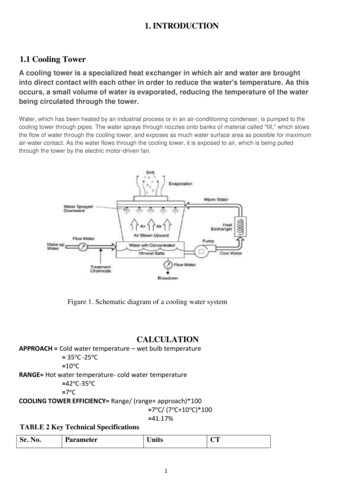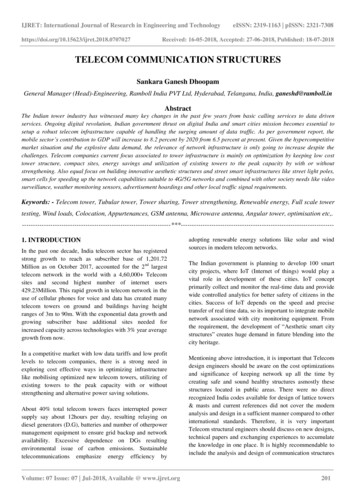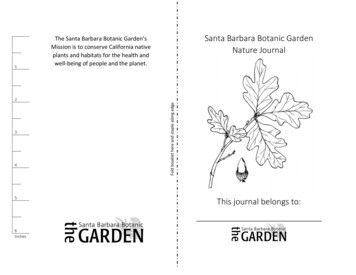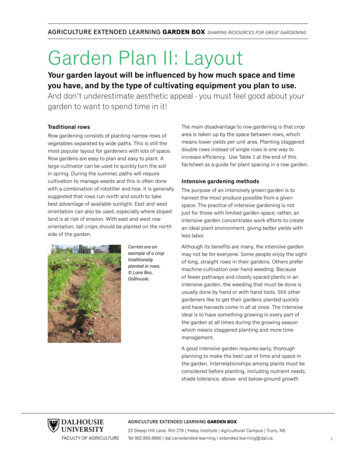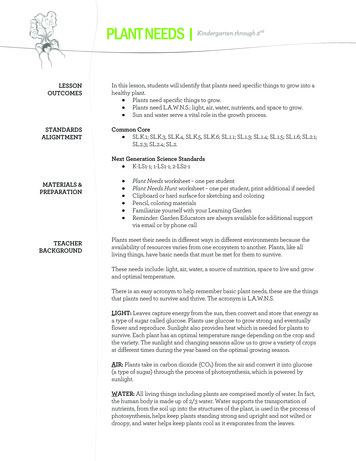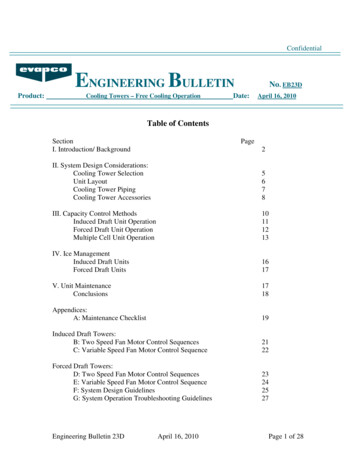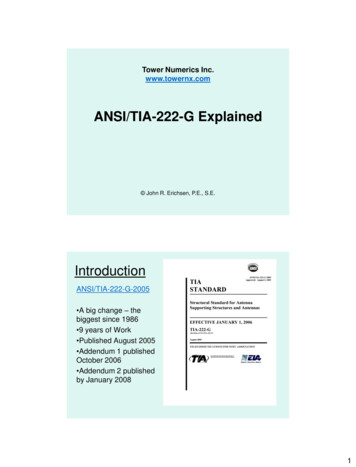
Transcription
PLANT LESSONLEARNING ABOUTPARTS OF PLANTSGrade 2 and upScienceRootsSome roots are called fibrous, branch out in all directions,and are about the same length. Monocots, like grasses, corn,and lilies, have fibrous roots.Others, called taproots, have a main downward growing rootwith smaller roots branching off from it. Carrots, radishes,beets, parsnips, and turnips are storage taproots since theyhold sugar and starches made in the leaves. Most dicot plantshave taproots.Root hairs are extensions of the root responsible for bringingwater into the plant.2 Next Generation Science Standards (NGSS):1Purpose and Content of Lesson:Roots will be visible in the Tower Garden plants because theywill not be hidden by soil. Growers of aeroponic plants may beamazed at the abundance of root growth in their plants. Rootsare the most overlooked parts of plants, because in nature, wedo not see them as we do the stems, leaves, and flowers. Rootscomprise about 1/4 to 1/3 the total weight of a plant and areessential to its growth and health.1The functions of the roots: Anchor the plant in the ground Bring water with dissolved minerals into the plantfrom the ground Store products of photosynthesis from the leaves(sugars, rg/search-standardsDisciplinary Core IdeasLS1.A: Structure and FunctionAll organisms have external parts. Plants have differentparts (roots, stems, leaves, flowers, fruits) that help themsurvive and grow. (Grades K-2)Plants and animals have both internal and externalstructures that serve various functions in growth, survival,behavior, and reproduction. (Grades 3-5)LS1.D: Information ProcessingPlants respond to some external inputs. (Grades K-2)3 Common misconceptions about roots:The idea that water is absorbed into the plant by the leavesis a misconception. Water being absorbed by undergroundroots in the soil cannot be observed; but droplets on the leavescan be observed, further supporting this misconception.The notion that nutrients and water that come from the soilare “food” for the plant is another misconception. Fertilizeris called “plant food,” and we know that plants need water togrow. Young learners may have difficulty believing, therefore,that leaves make the food for the plant.4Lesson Objective:Learners will explain the function of roots, recognize twotypes of roots (fibrous and taproot), and describe how theygrow in their science journals.Developed by: Debra Zinicola, Ed.D., Seton Hall University, Chair, Department of Educational Studies, andMarian Glenn, Ph.D., Seton Hall University, Professor, Department of Biological Sciences
5Lesson Procedure—THE LEARNING CYCLE: The Five EsEXPLOREKey questions for Seed Dissection lab:1. What do roots look like?ENGAGE2. What is their function?Living things need water, and plants are living organisms.How do they get their water?Root investigation:Have trays prepared for students to observe in groups withfive or less assorted plants having a variety of taproots(dicots) and fibrous roots (monocots). Find plants in seasonin your yard or at the garden center.Begin with a house plant in a pot.Ask: If I am going to water this plant, what part do I water?Why? When it rains, how does water get into a tree?Say to the students:Identify any misconceptions about watering the leaves andexplain that leaves do not bring water into the plant. Tellstudents that in this lesson you’ll examine the part of theplant that provides water.Different types of roots will be explored today. On yourobservation tray are several types of plants with visible rootsystems. Examine each, and with your group members, dividethe roots into two categories by some property or characteristic other than the fact that some are edible. Be ready toexplain by which property you divided your roots. Also makeat least five observations of your roots in your science journal and draw each type. Fill in the chart in the Appendices onpage four using names of the plants supplied by the teacher.Project the following 0/Botanical Illustration - Glorious grasses - June14th 2013EXPLAINHave each group share some of their observations and theircharacteristics for dividing their roots into two groups. Helpthem see (if they didn’t already) how the taproots (radish,dandelion, carrot) have a main root with smaller rootsbranching off. Help them also see that the fibrous roots do nothave one main root but branch out all over equally.Discuss how the roots have small hairs that absorb water fromthe soil and bring it into the root, then it continues to the stemthrough xylem tubes. Give out hand lenses to see if root hairsare visible, although they are invisible to the naked eye. Alsomention that familiar edible roots have more stored sugarsand starches (carrot, turnip, beet, radish, yam, horseradish,parsnip, ginger, jicama, rutabaga, Jerusalem artichokes) thanother taproots. They are called storage taproots.Critical thinking questions for groups to discuss then sharewith the class:1. Do you think desert plants (experiencing low rainfall)have deep or shallow roots? Explain.If you have cactus plants available, show the students theroots. They are typically shallow to get surface water whenit rains. Deep roots would not yield water far into the dryground unless there was an underground spring or aquafer.Talk about the parts of the plant — roots, stem, and leavesand how water gets into the plant through roots via roothairs and travels up the stem to the leaves where the plant’sfood is made. The xylem and phloem vessels that bring fluidsthrough the root systems are also found in stems. Do not yettalk about the two different types of roots since that is thepurpose of the following investigation.2. Do you think root vegetables are suitable for growth ina Tower Garden? Explain.Storage roots pick up more nutrients from the soil aroundthem and stored sugars and starches from the leaves. Hydroponically grown carrots and other storage roots can get heavy,so they need a growing medium to support them, like vermic-2
ulite (a moisture retaining mineral product). A little bit ofvermiculite is used to plant seeds in wool cubes in the TowerGarden. Carrots, for example, also take a long time to grow— about three months, while other hydroponically grownplants can grow and be harvested more quickly.6Web ResourcesPlant Structures: Roots ml1Roots as anchors with images: NGA’s Learning ek1/page8.htm3. Why do you think some plants (like the ones we call“weeds”) sometimes grow back after we pull them outof the ground?2Plants can grow back after you pull up the top growth. Thosewith long taproots, like dandelion (a foot or more in length),or those roots that spread by sending out rhizomes are especially prone to grow new shoots.3Carrot experiments to show function, structure of taproots:World Carrot Museum http://www.carrotmuseum.co.uk/experiment.htmlVideo of radish roots sprouting: Newton’s Apple WhatPlants Need d-to-live-and-grow/44. How might the function of roots in the Tower Gardenbe different from roots growing through soil? Howmight their function be the same?Flowering Plants: Roots http://leavingbio.net/flowering%20plants.htm5In the Tower Garden, roots begin in wool cubes, and thenextensive root development appears in the interior of thetower and roots hang down, but they do not anchor the plantin the same way as soil. The plants are not subject to effectsof strong winds, foot traffic, lawnmowers, or competition forresources. Roots still bring nutrient-rich water into the plant,but the root tip does not have to push through hard groundto grow.Content — Great Plant Escape: htmlBackground for Teacher: Botany html#rootsMaterials for Investigation: Have enough plants with exposed taproots and fibrousroots for students to observe in groups and classify.EXPAND Carrots with leaves and smaller roots attachedShow upper-grade students a cross section slice of a carrotthat was soaking in red food dye and water.3 This way theycan see the red portions as xylem; then they will also see thedistinctions between phloem and the cortex. They can drawand label in their science notebooks. Show also select imagesand videos under “Resources.” Carrots that have been soaked in dye and sliced Other storage taproot vegetables (radishes, turnips, beets) Other plants with taproots intact that are not foods (anydicot plant) Plants with fibrous roots (lilies, grasses, palms or anymonocot plant) Computer and projection to show videos and imagesimage3xylemphloemcortexepidermis7Additional Applications:Ask students to share their thoughts in groups on the following questions. After discussion, they can do research to seeif their hypotheses are correct and then share findings thefollowing day.EVALUATE1. What plant part is a sweet potato?a white potato? garlic?Students write the answer to the following questions in theirscience notebooks:(Sweet potato is a storage root, white potato is amodified stem, and garlic is a root)1. How would the growth of a plant be affected if itsroots were cut off? Suggest at least two ways.2. How do earthworms help plant roots grow?2. Watering a plant means to water the soil around theplant. Why is that so?(They move through dirt, loosening soil, and depositwaste that is rich in nutrients)A summative assessment is included at the end of the lessonon STEMS.3. How do ants help roots? (They dig tunnels and loosensoil to make space for growth)3
Appendices:Graphic handout on roots8Date:Name:Type of PlantObservations (write characteristics)Plant diagram (draw)grassradishdandelionlilycarrotTask: By what property or properties did your group divide your roots into two groups?4
All About RootsDEVELOPED BY:Debra Zinicola, Ed.D., Seton Hall University, Chair, Department of Educational Studies, andMarian Glenn, Ph.D., Seton Hall University, Professor, Department of Biological SciencesBY JUICE PLUS
The Roots of a Plant12What are the roots of a plant?What do the roots do for the plant?We don’t often see the plant’s roots, but they are very important.BY JUICE PLUS
The Function of Roots12Roots are organs of a plant thatanchor the plant in the ground.Why is that job important?What do you notice about these roots?BY JUICE PLUS
The Function of RootsIn addition toanchoring the plant,roots bring waterwith dissolved mineralsfrom the groundinto the plant.BY JUICE PLUS
The Function of RootsRoot hairs are extensions of the root responsiblefor bringing water into the plant.Root hairs are too small tosee without magnification.Root hairsBY JUICE PLUS
The Function of RootsIn addition to anchoring the plant andbringing water into the plant, roots also:Store sugars and starches—products of photosynthesisfrom the leaves.Some roots are calledstorage roots.BY JUICE PLUS
The Function of RootsLet’s Review:What do roots do for a plant?1the plant.2Bring with dissolved mineralsfrom the into the plant.3Store andmade in the leaves through photosynthesis.BY JUICE PLUS
The Function of RootsWere you correct?What do roots do for a plant?123Anchor the plant.water with dissolved mineralsBringground into the plant.from thesugars andcarbohydratesStoremade in the leaves through photosynthesis.BY JUICE PLUS
Root SystemsTwo kinds of root systems:1Fibrous roots branch out in all directionsand are about the same length.Grasses, corn and lilies have fibrous roots2Taproots have a main downward growingroot with small roots branching off of it.Carrots, radishes, beets, potatoesand turnips are storage taprootssince they hold sugar and starchesmade in the leaves.BY JUICE PLUS
Root Systems1Which root system is fibrous?2Which root system is a taproot system?3Explain.ABBY JUICE PLUS
Questions About Roots1What plant part is a sweet potato?A white potato?Garlic?2How do earthworms help plant roots grow?3How do ants help plant roots grow?BY JUICE PLUS
Questions About Roots1Do you think desert plants (experiencing low rainfall)have deep or shallow roots? Explain.2Do you think root vegetables (such as potatoes) aresuitable for growth in a Tower Garden? Explain.3Why do you think some plants (like the ones we call“weeds”) grow back after we pull them out of the ground?4How might the function of roots in a Tower Garden bedifferent from roots growing in soil? How might theirfunction be the same?BY JUICE PLUS
Roots AssessmentWrite your answers to the questions below.1How would the growth of a plant beaffected if its roots were cut off?Suggest at least two ways.2Why does “watering a plant” meanto water the soil around the plant?BY JUICE PLUS
3. Why do you think some plants (like the ones we call "weeds") sometimes grow back after we pull them out of the ground? Plants can grow back after you pull up the top growth. Those with long taproots, like dandelion (a foot or more in length), or those roots that spread by sending out rhizomes are espe-cially prone to grow new shoots. 4.


